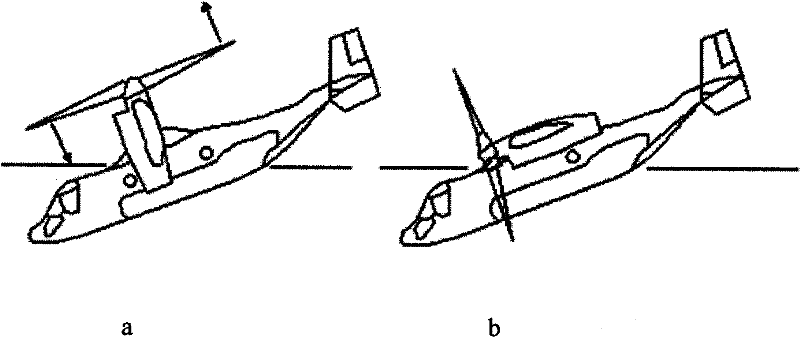Tiltrotor controlled by double-propeller vertical duct
A technology of double propellers and tilting rotors, which is applied in the direction of rotorcraft, aircraft, motor vehicles, etc., can solve the problems of short control force arm, complex control mode, and complex structure of periodic pitch change mechanism, etc., to reduce the size of the duct , the effect of reducing flight resistance
- Summary
- Abstract
- Description
- Claims
- Application Information
AI Technical Summary
Problems solved by technology
Method used
Image
Examples
Embodiment Construction
[0058] See Figure 4 ~ Figure 8 Shown, the present invention uses a kind of tilt rotor aircraft controlled by double propeller vertical duct, this aircraft adopts the design of side by side double rotor, conventional aerodynamic layout, and it is made of fuselage 1, straight wing 2, rotor 3, short Cabin 4, aileron 5, vertical tail 6, rudder 7, elevator 8, horizontal tail 9, landing gear 10, power and deceleration system 11 and double propeller vertical duct structure 12. The straight wing 2 is installed on both sides of the middle section of the fuselage 1, the rotor 3 is installed on the end of the nacelle 4, the main body of the landing gear 10 is located at the belly of the fuselage 1, and the straight wings 2 on both sides of the fuselage 1 support the The nacelle 4 at the end, the aileron 5 is connected to the outside of the wing 2, the horizontal stabilizer 9 is connected to the tail of the fuselage 1, the elevator 8 is connected to the rear of the horizontal stabilizer ...
PUM
 Login to View More
Login to View More Abstract
Description
Claims
Application Information
 Login to View More
Login to View More - R&D
- Intellectual Property
- Life Sciences
- Materials
- Tech Scout
- Unparalleled Data Quality
- Higher Quality Content
- 60% Fewer Hallucinations
Browse by: Latest US Patents, China's latest patents, Technical Efficacy Thesaurus, Application Domain, Technology Topic, Popular Technical Reports.
© 2025 PatSnap. All rights reserved.Legal|Privacy policy|Modern Slavery Act Transparency Statement|Sitemap|About US| Contact US: help@patsnap.com



